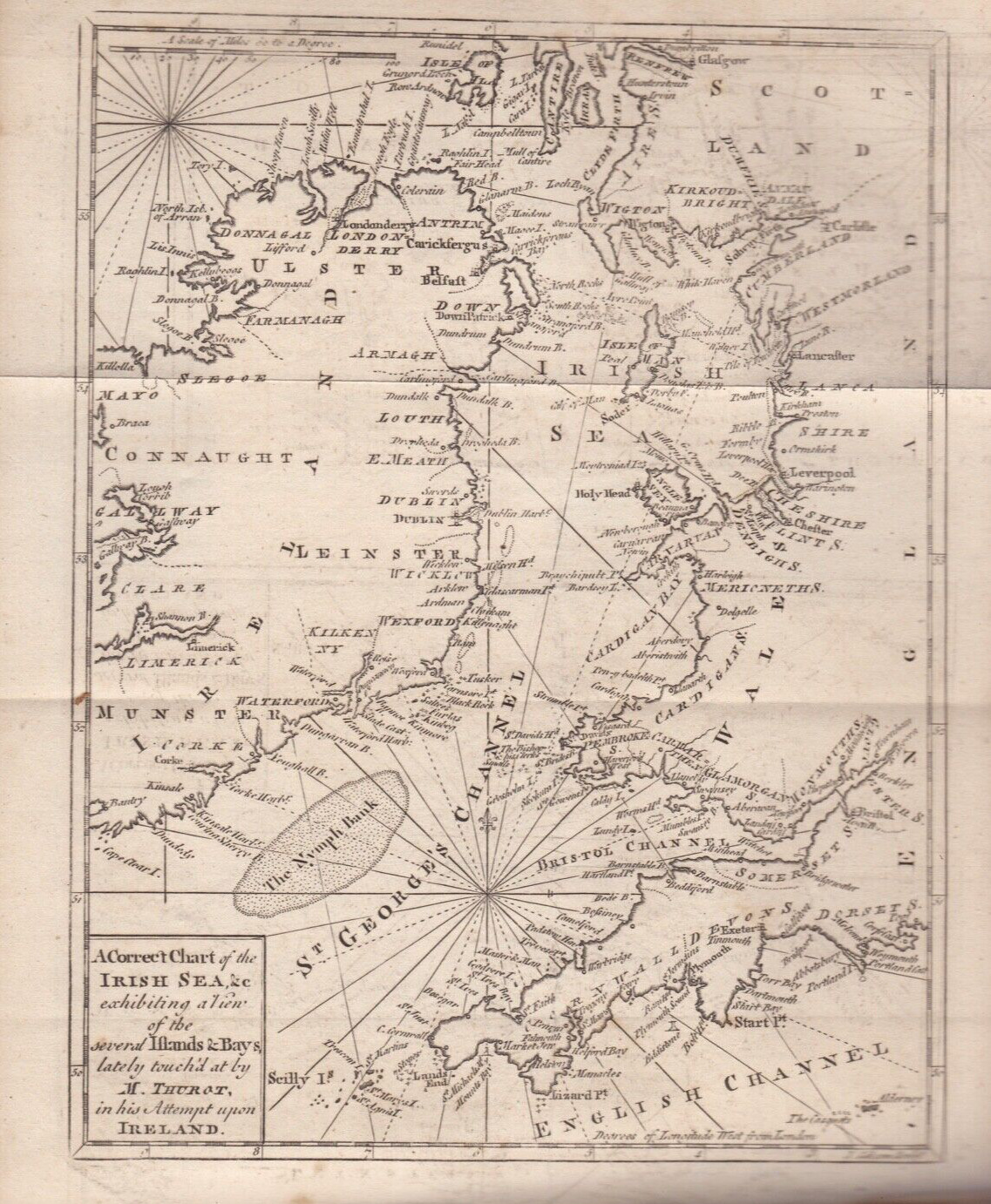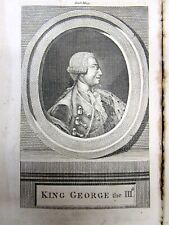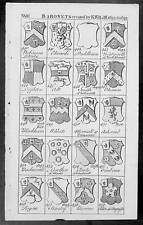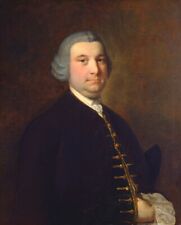|

On eBay Now...
1760 Gentleman\'s Magazine- Correct Chart of the Irish Sea - Lord Sackville Trial For Sale

When you click on links to various merchants on this site and make a purchase, this can result in this site earning a commission. Affiliate programs and affiliations include, but are not limited to, the eBay Partner Network.

1760 Gentleman\'s Magazine- Correct Chart of the Irish Sea - Lord Sackville Trial:
$45.00
A complete 48 page issue of \"The Gentleman\'s Magazine\" dated March 1760. This monthly London magazine was published from 1731 until 1922, a period of almost 200 years - see history below.
The magazine provides reports primarily from England but also from around the world on a wide variety of subjects and interests, usually including two or more engraved illustrations. Wars, disasters, crimes, trials and punishments are widely reported.
This issue is particularly desirable because of the superb fold-out map by John Gibson entitled \"A Chart of the Several Islands & Bays lately touch\'d at by M.Thurot in his Attempt upon IRELAND\". (size 10 x 8.5 inches). Thurot had been killed in the previous month at the Battle of Bishop\'s Court - see scans and below.
Other news of interest includes:
Details from South Carolina that Governor William Lyttletonhad signed a peace treaty with the Cherokee nation - see scan. The report ends, however, with news that despite the peace agreement the Cherokees have renewed their killings. - see scan A full account of the famous Court Marshall of Lord Sackville, which found him guilty of disobeying orders - see scan and below
The mortality tables for London confirmed that 30% of deaths for the prior month were children below the age of 2 - childbirth was a risky affair atthis time
Good condition. After six or twelve months the monthly issues were usually taken by the subscriber to the bookbinder for safe retention. In this case the issue has subsequently been dis-bound.
Page size 8 x 5 inches. A great and interesting resource for the historian. Note that another copy of the map is currently offered on for $132.00
The Gentleman\'s Magazine17 languagesToolsFrom Wikipedia, the free encyclopediaFront page ofThe Gentleman\'s Magazine, May 1759The Gentleman\'s Magazinewas a monthly magazine[1]founded inLondon, England, byEdward Cavein January 1731.[2]It ran uninterrupted for almost 200 years, until 1922. It was the first to use the termmagazine(from theFrenchmagazine, meaning \"storehouse\") for aperiodical.[3]Samuel Johnson\'s first regular employment as a writer was withThe Gentleman\'s Magazine. HistoryThe original complete title wasThe Gentleman\'s Magazine: or, Trader\'s monthly intelligencer. Cave\'s innovation was to create a monthly digest of news and commentary on any topic the educated public might be interested in, from commodity prices toLatin poetry. It carried original content from a stable of regular contributors, as well as extensive quotations and extracts from other periodicals and books. Cave, who editedThe Gentleman\'s Magazineunder thepen name\"Sylvanus Urban\", was the first to use the termmagazine(meaning \"storehouse\") for a periodical. Contributions to the magazine frequently took the form of letters, addressed to \"Mr.Urban\". The iconic illustration ofSt.John\'s Gateon the front of each issue (occasionally updated over the years) depicted Cave\'s home, in effect, the magazine\'s \"office\". Before the founding ofThe Gentleman\'s Magazine, there were specialised journals, but no such wide-ranging publications (although there had been attempts, such asThe Gentleman\'s Journal, which was edited byPeter Motteuxand ran from 1692 to 1694). Samuel Johnson\'s first regular employment as a writer was withThe Gentleman\'s Magazine. During a time when parliamentary reporting was banned, Johnson regularly contributed parliamentary reports as \"Debates of the Senate of Magna Lilliputia\". Though they reflected the positions of the participants, the words of the debates were mostly Johnson\'s own. The name \"Columbia\", a poetic name for America coined by Johnson, first appears in a 1738 weekly publication of the debates of the British Parliament in the magazine.[4][5] The magazine\'s long-running motto,E pluribus unum, Latin for \"Out of many, one\", is thought to have inspired the use of the phrase as an unofficial motto of the United States. Motteux\'sThe Gentleman\'s Journalhad previously used the phrase.[6][7][8] A skilled businessman, Edward Cave developed an extensive distribution system forThe Gentleman\'s Magazine. It was read throughout the English-speaking world and continued to flourish through the 18th century and much of the 19th century under a series of different editors and publishers. It went into decline towards the end of the 19th century and finally ceased general publication in September 1907. However, issues consisting of four pages each were printed in very small editions between late 1907 and 1922 in order to keep the title formally \"in print\". Francois Thurot - 28 February 1760, the last battleFurther information:Battle of Bishops CourtThe action took place offBishops Courtbetween Captain Elliott and the French Captain ThurotThree British ships caught up with Thurot\'s squadron on 28 February 1760, anchored at the entrance of Luce Bay. To avoid being trapped in the bay, Thurot\'s squadron set sail for the south-east, towards theIsle of Man. At about sunrise the leader of the British squadron,Æoluscaught up with theMaréchal de Belle-Isleand battle began (within sight of theMull of Gallowayand Jurby Head on Man). After the first broadsides, Thurot tried to grappleÆolusso he could use his troops to board, but all he achieved was the loss of hisbowsprit, and of many men on deck from British small-arms fire. NextÆolusfired a second broadside, and neatly fell back so that the other two Royal Navy vessels could also fire at theBelle-Isle. ThenÆolusresumed the fight, whilePallasandBrilliantwent to deal with the remaining French vessels, one of which,Terpsichoreattempted to escape but was easily caught byPallas. François was killed about the time of the second broadside, apparently by a musket-ball, and after a boarding party eventually got aboard, his crew surrendered. News reports claimed that aboard theBelle-Islewas found a young woman fromPaddington, whom Thurot had met inLondona few years previously, and had accompanied him on all his subsequent adventures—presumably the origin of the story of Miss Smith.[17]Some 160 men had been killed aboardBelle-Islealone, compared to four killed and eleven wounded aboardÆolus. At some point, Thurot\'s corpse was thrown overboard, with many others, and it washed ashore in Monreith Bay. It was variously claimed that he was dressed in an ordinary sailor\'s uniform, and hence not recognised, or, on the contrary, that his corpse was found sewed up in the silk-velvet carpet from his cabin). He was buried with full honours in the churchyard ofKirkmaiden-in-Fernis, at the expense of the local laird, Sir William Maxwell Bt., ofMonreithwho also served as chief mourner.[18]Within half a century, the grave marker was gone, but the site was remembered, and a new marker has since been provided. Having been so greatly feared in Britain, he was also mourned, and celebrations of his defeat paid him considerable respect. A widely circulated news report observed that \"he had justly acquired, and has left behind him, the two most amiable Characteristicks of a Sailor or Soldier, intrepid Courage, and extensive Humanity\", and a published letter from London reported that \"most people here are sorry for his Death, as he on all Occasions behaved like a brave Officer, and a Gentleman.\"[19]The artist,Richard Wright, witnessed the battle and produced paintings showing the action[20]and the aftermath, which were both made into engravings. Ballads were written about the Carrickfergus raid and the last battle, and a biography of Thurot by the Rev. John Francis Durand was in the shops by June,[18]in two editions priced at 1s or 6½d; sadly, despite the author\'s claims to have known Thurot for years, the work consisted mostly of old news stories and outright fabrications.
Lord Sackville - Court martialSackville refused to accept responsibility for refusing to obey orders. Back in England, he demanded acourt martial, and made it a large enough issue that he obtained his demand in 1760. The court found him guilty, and imposed one of the strangest and strongest verdicts ever rendered against a general officer. The court\'s verdict not only upheld his discharge but also ruled that he was \"unfit to serve His Majesty in any military Capacity whatever\", then ordered that their verdict be read to and entered in the orderly book of every regiment in the army.[9]The king had his name struck from thePrivy Councilrolls.[10]


1760 Gentleman's Magazine- Correct Chart of the Irish Sea - Lord Sackville Trial $45.00

1760 newspaper / news magazine KING GEORGE III contemporary engraving / portrait $125.00

1760s England Chelsea J Willems Boccage Porcelain Figurines Candlesticks 11" $999.99

1760 Gents Mag Antique Print of Baronets Created by King William III 1690-99 $35.00

Oil painting Portrait-of-a-Gentleman-c.-1760-Joseph-Wright-oil-painting handmade $76.99
|